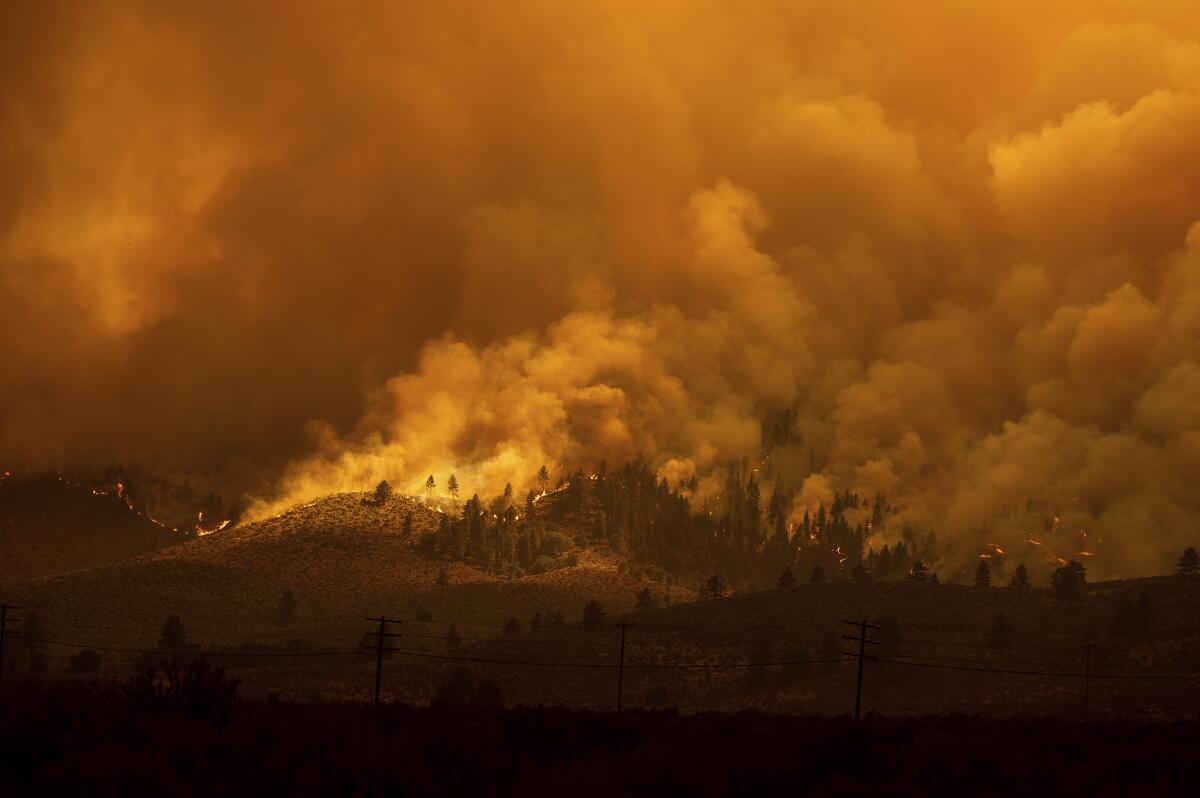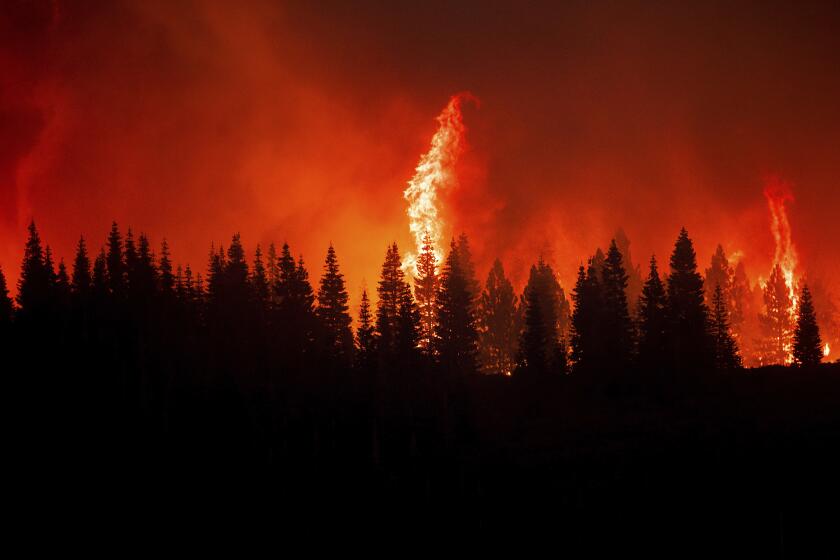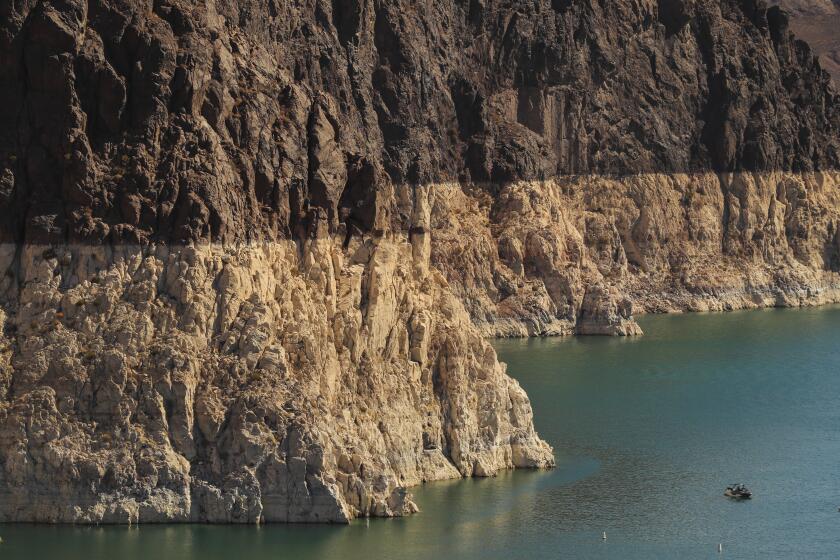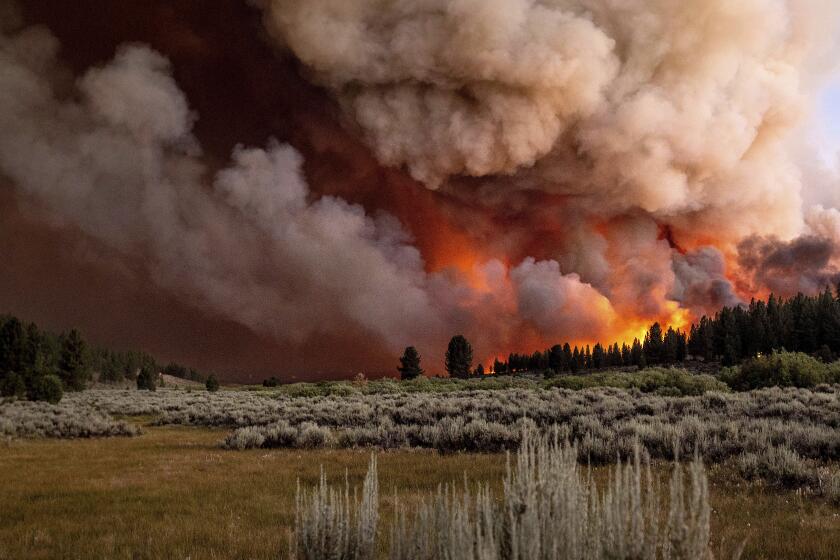California fires are burning faster, hotter, more intensely — and getting harder to fight

- Share via
The fires have burned more than 140,000 acres, from soaring mountains along the California-Nevada border to forest north of Mt. Shasta and the gateway to Yosemite.
But many of 2021’s biggest blazes have one thing in common: They are burning faster and hotter than some firefighters have seen this early in the year.
A winter and spring of little rain and minimal snow runoff — followed by months of unusually warm conditions and several summer heat waves — left the vegetation primed to burn fast, giving crews little time to get a handle on the flames before they explode.
Vegetation is at record-dry levels for this time of the year, and it is at least six weeks ahead of where it should be, UCLA climate scientist Daniel Swain said. It is most anomalously dry in Northern California, where many of the recent fires have ignited.
Though the bone-dryness alone can’t foretell how many fires will ignite in a given year, Swain said, it can say a lot about the character of the fires that occur.
Already this year, there have been more than twice as many acres burned than during the same period last year — and hundreds more fires.
“All else equal, drier vegetation means more intense fires,” Swain said, noting that “intensity” refers both to the heat of a fire and to its behavior.
Intense fires fueled by dry vegetation “have a greater tendency to do things like hop over barriers, jump over control lines or roads or bodies of water, or to create their own weather conditions,” he said.
It took less than 10 days for the lightning-sparked Lava fire in Shasta-Trinity National Forest to swell to 25,000 acres after igniting at the end of June, but it held the title of the year’s largest wildfire only briefly.
The Sugar fire in Plumas County ignited July 2, and within 10 days it, too, had mushroomed in size to nearly 90,000 acres.
Variables such as wind and terrain can affect the speed of a fire, but Sugar fire officials said extreme dryness was one of the driving forces behind the rapid growth of the blaze, which is now poised to become the first 100,000-acre megafire in California this season.
In fact, experts said, dryness is the “X factor” behind many of California’s recent conflagrations. The dryness of the vegetation, primed by both long-term drought and shorter-term heat waves, is turning terrain into kindling, making it easy for fires to ignite and even easier for them to spread.
Lake Mead is at the lowest water levels in its 85-year history. Federal officials who manage the lake expect to soon declare a water shortage.
The current lack of moisture has had severe ramifications on the Golden State’s landscape.
From July 2020 to June of this year, the city of Los Angeles received only 41% of its typical rainfall, while the Northern Sierra region recorded its third driest year on record. The statewide snowpack was well below where it should have been heading into April, when it is typically the deepest.
“Fires on average are getting more severe, they are happening more frequently, they are increasing in size and the seasonality is extending,” said Morgan Tingley, an associate professor of ecology and evolutionary biology at UCLA, noting that the fire season is now beginning in June and continuing well into December.
“That dryness,” Tingley added, “just creates these tinderbox conditions.”
So far this year, many of the worst behaviors of wildfire have become a reality — as when crews battling the Sugar fire were set back substantially after a wind-whipped ember jumped containment lines and ignited a new blaze.
The fire had been 70% contained at 490 acres last Tuesday, four days after it ignited. Crews were focused on the southern border after infrared imagery showed little heat in the area where the fire had started, operations sections chief Jake Cagle said at a recent community briefing.
But when the fire reemerged there and began to grow rapidly amid an intensifying heat wave, it was moving so quickly that crews could not immediately establish an anchor point, or point of control, and the fire began to hook around them.
“For firefighter safety, they had to disengage,” Cagle said.
Crews continued fighting the fire from the air while they looked for an opportunity to get boots back on the ground, he said. But by Wednesday morning, the fire had grown nearly fivefold, to 2,365 acres, and containment had dropped to 28%.
By Friday, it had grown so large and was burning so intensely that it generated a massive pyrocumulonimbus cloud that created its own lightning and was flinging embers about a mile ahead of the main fire, officials said, making gaining ground a challenge.
Swain said the “pyro-vortex” over the Sugar fire was one example of fires creating their own weather patterns, which can also include strong winds, tornadoes and massive smoke plumes.
“Once [the fires] become intense enough, you don’t need externally extreme weather conditions,” he said. “They start creating their own.”
Already this year, there have been more than twice as many acres burned than during the same period last year — and hundreds more fires.
But the extreme dryness isn’t only contributing to hotter, faster and more frequent fires — it is also making it more challenging for residents to escape.
When a vehicle sent flammable material into dry bush along Interstate 5 in Shasta County on June 30, it sparked the Salt fire, which soon spread to more than 12,600 acres and destroyed at least 27 homes.
One resident said he had 10 minutes to flee before the fire reduced his home to ashes.
Another resident, Chris Barker, 62, said she and her husband, Ron, fled to a motel with legal papers, family photos, a dirty clothes hamper and their pets.
Barker said she knew their Gregory Acres community was fireprone, but that no significant fire had come through the area in 68 years. Two days after they fled, they learned their home was destroyed.
“Everything else on our street on both sides is just black,” Barker said. “You can tell it burned so hot. There are areas that are nothing but white ash and some little spindle trees. Just total devastation.”
Fire officials later told the couple that given the fire’s speed and ferocity, their home didn’t stand a chance.
“It was fueled by wind, and it just burned right down through the canyon and took everything it wanted,” she said.
Swaths of California saw record-breaking temperatures this weekend amid an intense heat wave that has increased fire risks and strained the energy grid.
And while much of the state’s extreme fire behavior can be attributed to the drought, rising global temperatures characterized by more frequent extreme heat waves are also a significant factor, experts said.
Triple-digit temperatures soared across the Southland over the weekend, while much of the Pacific Northwest was recently mired in a deadly and record-breaking heat dome.
In 2015, climate scientist Alex Hall co-wrote a study that found the size of wildfires are closely linked to both heat and dryness. The study predicted that by 2050, fire would each year burn twice as many acres in Southern California, on average.
But the region is on pace to reach that mark much sooner: In 2020, for example, fires scorched twice as much land statewide as they did in 2018.
Hall said the recent rapid increase in fire behavior could in part be due to bigger swings between wet and dry years that have caused vegetation to grow and then dry out, and aggressive fire suppression tactics that have caused a buildup of dead and dry fuels in forested areas.
It might also be because the researchers based their predictions on historical records going back decades, and modern conditions are increasingly blowing the conditions that produced those records out of the water.
“That might be a different [fire] regime from the one we’re in now, where the fires are just behaving differently because there’s a warmer climate,” he said.
Adding to fire experts’ concerns is the fact that much of the dry vegetation this year hasn’t yet encountered severe winds, which tend to arrive in the form of Santa Anas and sundowners later in the year.
When the extreme dryness does meet strong winds — as in Sunday afternoon’s River fire in Yosemite — it can quickly spell disaster.
That fire exploded to 2,500 acres in just a few hours. By Monday evening, it had spread to 8,000 acres and was only 10% contained.
More to Read
Sign up for Essential California
The most important California stories and recommendations in your inbox every morning.
You may occasionally receive promotional content from the Los Angeles Times.














